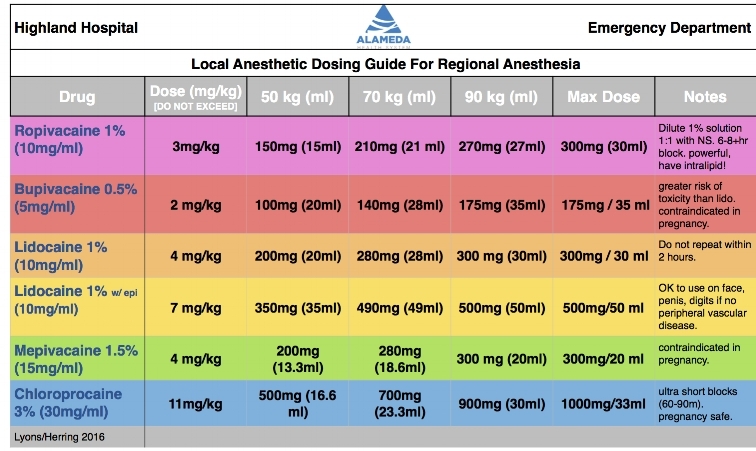Local Anesthetics
Properties of Anesthetic Agents

Local Anesthetic Systemic Toxicity (LAST)
Background
- Life-threatening adverse reaction to local anesthetic toxicity
- Occurs in ~0.2% of nerve blocks
- Generally occurs within minutes of injection
Causes
- Injection of local anesthetic into systemic circulation
- Most common source of toxicity
- Intravascular injection can cause toxicity below the maximum recommended dose
- Exceeding the maximum dose of local anesthetic (see table above)
- Absorption of anesthetic into systemic circulation by injection into extremely vascular area
Clinical Features
- CNS
- Auditory changes/Tinnitus
- Metallic taste
- Seizures or drowsiness
- Coma
- Respiratory arrest
- Cardiovascular
- Early signs
- Tachycardia
- Ventricular dysrhythmia
- Hypertension
- Late signs
- Bradycardia
- Conduction block
- Cardiovascular collapse
- Asystole
Management
- Aggressive supportive care: Airway management, ACLS, seizure management
- NaHCO3 1 ampule IV q2 minutes for: VT/VF, severe acidosis
- Lipid emulsion 20% solution
- 1.5 mL/kg bolus over 1 minute
- Then, 0.25 mL/kg/min for 20 min or until hemodynamic stability achieved
- ↑ to 0.5 mL/kg/min if hemodynamic status declinesc
- Maximum total dose 12 mL/kg.
Source
- Highland Ultrasound
- WikEM

Recent Comments